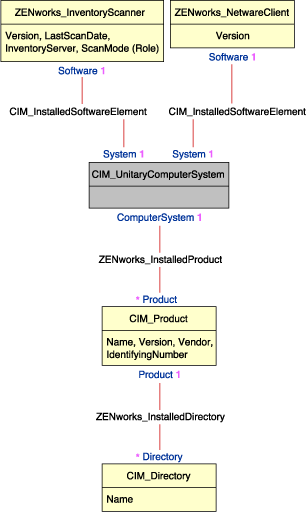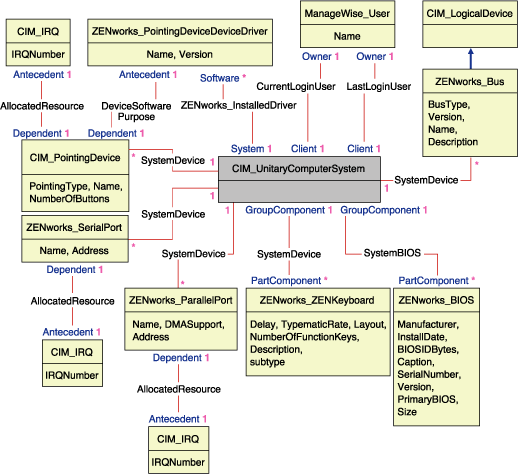
The following section describes the database schema classes and the extensions and associations made to the CIM schema for use in ZfS. These extensions have ZENworks or ManageWise as their schema name. ZENworks.classname refers to the extended class in the ZENworks schema and ManageWise.classname refers to the extended class in the ManageWise schema.
The following sections will help you understand the ZfS 3 database schema:
The following scenario describes an inventoried server that has two parallel ports with a specified interrupt number.
In the following schema diagram, the CIM_UnitaryComputerSystem represents a managed inventory system.
In this illustration, class CIM.PointingDevice associates to CIM.UnitaryComputerSystem using the association CIM.SystemDevice with SystemDevice.GroupComponent pointing to CIM.UnitaryComputerSystem and SystemDevice.PartComponent pointing to CIM.PointingDevice. The relationship between the two classes is one to many. This means a computer system might have more than one pointing devices.
Class CIM.IRQ associates to CIM.PointingDevice using the association CIM.AllocatedResource. Dependent pointing to CIM.PointingDevice and Antecedent pointing to CIM.IRQ.
Class ZENworks.ZENKeyboard associates to CIM.UnitaryComputerSystem using the association CIM.SystemDevice with SystemDevice.GroupComponent pointing to CIM.UnitaryComputerSystem and SystemDevice.PartComponent pointing to ZENworks.ZENKeyboard. The relationship between the two classes is one to one. This means a computer system can have only one Keyboard.
Class ZENworks.BIOS associates to CIM.UnitaryComputerSystem using the association CIM.SystemDevice with SystemDevice.GroupComponent pointing to CIM.UnitaryComputerSystem and SystemBIOS.PartComponent pointing to ZENworks.BIOS. The relationship between the two classes is one to one. This means a computer system can have only one BIOS.
Class CIM.ZENworks.ParallelPort associates to CIM.UnitaryComputerSystem using the association CIM.SystemDevice with SystemDevice.GroupComponent pointing to CIM.UnitaryComputerSystem and SystemDevice.PartComponent pointing to CIM.ZENworks.ParallelPort. The relationship between the two classes is one to many. This means a computer system might have more than one parallel port.
Class ZENworks.BUS associates to CIM.UnitaryComputerSystem using the association CIM.SystemDevice with SystemDevice.GroupComponent pointing to CIM.UnitaryComputerSystem and SystemBUS.PartComponent pointing to ZENworks.BUS. The relationship between the two classes is one to one. This means a computer system can have only one BUS.
Class ManageWise.Usera associates to CIM.UnitaryComputerSystem using CurrentLoginUser and LastLoginUser. In the CurrentLoginUser association, the specific instance of User is the one who is currently logged into the inventoried server. In the LastLoginUser association, the specific instance of User is the one who logged last into the inventoried server.
Class CIM.IRQ associates to CIM.ParallelPort using the association CIM.AllocatedResource. Dependent pointing to CIM.ParallelPort and Antecedent pointing to CIM.IRQ.

The schema diagram illustrates the following:
There are three instances of ZENworks_ParallelPort associated to one instance of: CIM_UnitaryComputerSystem using three instances of CIM_SystemDevice associations, CIM_SystemDevice.GroupComponent references UnitaryComputerSystem, CIM_SystemDevice.PartComponent references ParallelPort.
This is called 1 to n object reference relationship and is depicted in the illustration as 1..*. Similarly, every instance of ParallelPort has a corresponding instance of CIM_IRQ designating the port's irq. This is one-to-one relationship and is depicted as 1..1.
All other classes follow similar representation. For an explanation of the CIM and extended classes, see CIM Classes and Extension Classes in ZfS . For schema diagrams of other classes, see Schema Diagrams of CIM and the Extension Schema in ZfS .
The legends for reading the schema diagrams are as follows:
For an explanation about CIM schema, see the CIM 2.2 schema specification on the DMTF Web site.
The following table describes the CIM and extension classes that ZfS uses:
The following schema diagrams of the CIM and extension schema model the Inventory database in ZfS.
In the following schema diagram, the CIM_UnitaryComputerSystem represents a managed inventory system.
In this illustration, class CIM.PointingDevice associates to CIM.UnitaryComputerSystem using the association CIM.SystemDevice with SystemDevice.GroupComponent pointing to CIM.UnitaryComputerSystem and SystemDevice.PartComponent pointing to CIM.PointingDevice. The relationship between the two classes is one to many. This means a computer system might have more than one pointing devices.
Class CIM.IRQ associates to CIM.PointingDevice using the association CIM.AllocatedResource. Dependent pointing to CIM.PointingDevice and Antecedent pointing to CIM.IRQ.
Class ZENworks.ZENKeyboard associates to CIM.UnitaryComputerSystem using the association CIM.SystemDevice with SystemDevice.GroupComponent pointing to CIM.UnitaryComputerSystem and SystemDevice.PartComponent pointing to ZENworks.ZENKeyboard. The relationship between the two classes is one to one. This means a computer system can have only one Keyboard.
Class ZENworks.BIOS associates to CIM.UnitaryComputerSystem using the association CIM.SystemDevice with SystemDevice.GroupComponent pointing to CIM.UnitaryComputerSystem and SystemBIOS.PartComponent pointing to ZENworks.BIOS. The relationship between the two classes is one to one. This means a computer system can have only one BIOS.
Class CIM.ZENworks.ParallelPort associates to CIM.UnitaryComputerSystem using the association CIM.SystemDevice with SystemDevice.GroupComponent pointing to CIM.UnitaryComputerSystem and SystemDevice.PartComponent pointing to CIM.ZENworks.ParallelPort. The relationship between the two classes is one to many. This means a computer system might have more than one parallel port.
Class ZENworks.BUS associates to CIM.UnitaryComputerSystem using the association CIM.SystemDevice with SystemDevice.GroupComponent pointing to CIM.UnitaryComputerSystem and SystemBUS.PartComponent pointing to ZENworks.BUS. The relationship between the two classes is one to one. This means a computer system can have only one BUS.
Class ManageWise.User has two associations with CIM.UnitaryComputerSystem; CurrentLoginUser and LastLoginUser. In the CurrentLoginUser association, the specific instance of User is the one who is currently logged into the inventoried server. In the LastLoginUser association, the specific instance of User is the one who logged last into the inventoried server.
Class CIM.IRQ associates to CIM.ParallelPort using the association CIM.AllocatedResource. Dependent pointing to CIM.ParallelPort and Antecedent pointing to CIM.IRQ.

The following are sample queries for retrieving the inventory information from the ZfS Inventory database.
Refer to the schema diagrams in Schema Diagrams of CIM and the Extension Schema in ZfS to find out the associated schema classes and attribute information.
SELECT u.id$,m.label,m.tree FROM managewise.NDSName
m,cim.UnitaryComputerSystem u,managewise.Designates s
where s.Designation=m.id$and s.HOST=u.id$
SELECT m.Tag,m.Manufacturer,m.SerialNumber FROM
cim.UnitaryComputerSystem u,zenworks.SystemInfo
m,cim.ComputerSystemPackage s WHERE s.Antecedent=m.id$and
s.Dependent=u.id$
SELECT m.name,m.version FROM cim.Product
m,cim.UnitaryComputerSystem u,zenworks.InstalledProduct
s,managewise.NDSName m1,managewise.Designates s1 WHERE
(s.Product=m.id$and s.ComputerSystem=u.id$) AND
(s1.Designation=m1.id$and s1.Host=u.id$) AND
m1.label='SJOHN164_99_139_79' and m1.tree='Novell_AUS'
SELECT
m.DeviceID,m.Family,m.Stepping,m.OtherFamilyDescription,
m.MaxClockSpeed,m.Role,m.UpgradeMethod FROM cim.Processor
m,cim.UnitaryComputerSystem
u,cim.ComputerSystemProcessor s managewise.NDSName
m1,managewise.Designates s1 WHERE
(s.PartComponent=m.id$and s.GroupComponent=u.id$) AND
m1.label='SJOHN164_99_139_79'
SELECT name from CIM.UnitaryComputerSystem WHERE
name='SJOHN164_99_139_79'
SELECT
m.DeviceID,m.Family,m.Stepping,m.OtherFamilyDescription,
m.MaxClockSpeed,m.Role,m.UpgradeMethod FROM cim.Processor
m,cim.UnitaryComputerSystem u,
cim.ComputerSystemProcessor s u.id$=? and
s.PartComponent=m.id$ and s.GroupComponent=u.id$
Substitute the ID of the specified inventoried server in place of the ? value for u.id in the query.
SELECT ip.Address, ipx.Address, mac.MACAddress FROM
cim.IPProtocolEndpoint ip, cim.IPXProtocolEndpoint ipx,
cim.LANEndpoint mac, cim.UnitaryComputerSystem u,
cim.HostedAccessPoint s WHERE (s.Dependent=ip.id$ and
s.Antecedent=u.id$) AND (s.Dependent=ipx.id$ and
s.Antecedent=u.id$) AND (s.Dependent=mac.id$ and
s.Antecedent=u.id$)
Modify the same query to get the information for a specified inventoried server as follows:
SELECT ip.Address, ipx.Address, mac.MACAddress FROM
cim.IPProtocolEndpoint ip, cim.IPXProtocolEndpoint ipx,
cim.LANEndpoint mac, cim.UnitaryComputerSystem u,
cim.HostedAccessPoint s WHERE (s.Dependent=ip.id$ and
s.Antecedent=u.id$) AND (s.Dependent=ipx.id$ and
s.Antecedent=u.id$) AND (s.Dependent=mac.id$ and
s.Antecedent=u.id$)AND u.id$=?
Use the query as shown in query 5 to retrieve the ID of the specified inventoried server and substitute the ID in place of the ? value for u.id in the query.
SELECT m.id$,n.id$,m.DeviceID,n.FileSystemSize,
n.AvailableSpace,m.VolumeSerialNumber,m.caption as
VolumeLabel, n.FileSystemType FROM
ZENworks.LogicalDiskDrive m,CIM.LocalFileSystem
n,CIM.HostedFileSystem s,CIM.ResidesOnExtent r WHERE
(s.GroupComponent=? and s.PartComponent=n.id$) AND
(r.Antecedent=m.id$and r.Dependent=n.id$)
Use the query shown in query 5to retrieve the ID of the specified inventoried server and substitute the ID in place of the ? for u.id$ in the query.